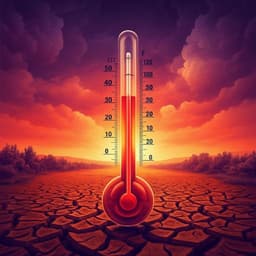
Biology
Climate change threatens Chinook salmon throughout their life cycle
L. G. Crozier, B. J. Burke, et al.
This groundbreaking study by Lisa G. Crozier and colleagues uncovers the worrying declines in Chinook salmon populations due to climate change. With a comprehensive analysis of survival data, the research sheds light on the vital need for increased smolt survival to combat the impacts of rising sea temperatures. Dive into the depths of this pressing environmental issue!
~3 min • Beginner • English
Introduction
The study addresses how anthropogenic climate change will affect the viability of individual Chinook salmon populations when climate drivers act across all life stages. Although widespread salmon declines have been linked to climate variability and numerous anthropogenic stressors, previous projections often focused on freshwater stages alone or relied on marine climate indices that cannot be directly linked to future GCM outputs. The authors set out to build quantitative, population-specific projections that incorporate carryover effects among life stages, integrate consistent climate forcing for freshwater and marine environments, and evaluate management-relevant risks (e.g., quasi-extinction thresholds) under future climate scenarios. The work is important for conservation and management because many ESUs are threatened, and decisions require forecasts that reflect full life-cycle dynamics under changing climate.
Literature Review
Prior predictive efforts emphasized freshwater drivers or used marine indices (e.g., PDO, AMO) that lack direct translation to GCM projections, limiting forward-looking analyses. Downscaling approaches for land and ocean often draw from different GCMs or methods (statistical hydrologic downscaling vs. ROMS), impeding consistent uncertainty characterization and carryover-effect modeling. Retrospective studies have shown strong salmon-climate relationships and nonstationarity across time, while niche-based forecasts addressed general habitat shifts rather than specific population dynamics. The authors highlight three gaps: (1) the need to quantify carryover effects between freshwater and marine stages, especially migration timing; (2) direct linkage of survival models to GCM-forced covariates to analyze future scenarios and their uncertainties; and (3) consistent, integrated climate forcing across freshwater and marine environments to preserve covariance structures relevant to migratory species with complex life histories.
Methodology
- Study system and scope: Eight wild populations within the Snake River spring/summer Chinook salmon ESU in the Salmon River Basin (Idaho) were modeled. These populations pass multiple hydroelectric dams before ocean entry and return after 1–4 years at sea. Recent 15-year mean spawner abundances ranged from ~45 to ~600.
- Life-cycle model: A stochastic, age-structured life-cycle model with density dependence and density-independent climate effects was developed. It included freshwater stages (spawner-to-parr, tributary rearing, downstream migration through Lower Granite and Bonneville dams) and the marine stage (ocean entry through return). Carryover effects were explicitly incorporated via covariate linkages among stages, including migration timing effects on survival and transport exposure.
- Environmental covariates: Freshwater covariates included air temperature and streamflow (summer and fall flows/temperatures). Marine covariates included basin-scale and coastal sea surface temperature (SST) indices and coastal upwelling.
- Data sources:
• Spawner abundance from state, tribal, and coordinating bodies; read-count based estimates for historical reconstruction.
• PIT-tag data for out-migrating yearling Chinook in the Snake River Basin (detections at Bonneville Dam, transport classifications), used to estimate smolt-to-adult returns (SAR).
• Hydrosystem passage and juvenile in-river survival modeled using the COMPASS framework (flow, temperature, spill) and route/transport proportions.
- Statistical models by stage:
• Smolt-to-adult return (SAR): Mixed-effects logistic regression with random effects of day and day-by-year; key predictors included large-scale and local SST metrics and ocean entry date (separate models for transported vs. in-river migrants).
• Adult spawner survival (hydrosystem to spawning streams): GAMMs assessed environmental and anthropogenic covariates; in simulations, non-environmental covariates were sampled from distributions reflecting 2004–2016 conditions; Sspawn held constant where relationships could not be fit.
- Calibration and fitting: Employed an approximate Bayesian computation-like approach. Large parameter sets were generated from priors, simulations were run under historical conditions (2000–2015), and parameter sets that reproduced observed spawner distributions (Kolmogorov–Smirnov p > 0.05) were retained to preserve correlation structure among parameters.
- Climate forcing and scenarios: A multivariate state-space model estimated covariance among air temperature and marine covariates; detrended simulations preserved autocorrelation, variance, and covariance. Future scenarios added deterministic GCM ensemble trends (RCP 4.5, RCP 8.5) to stochastic covariate trajectories, using median projections and interquartile ranges across models. Freshwater and marine forcing were integrated consistently to maintain cross-environment covariance; some sensitivity runs treated temperature and flow effects independently.
- Simulations and sensitivity analyses: Population trajectories were simulated through 21st century under detrended, RCP 4.5, and RCP 8.5 scenarios. Quasi-extinction threshold (QET50; running mean <50 spawners over any 4-year period) was used to assess risk. Alternative covariate sets (Models 1–3) tested sensitivity to freshwater (summer vs. fall flow/temperature) and marine (SST with/without upwelling) drivers, and life-stage-specific imposition of RCP 8.5 trends evaluated stage sensitivities.
Key Findings
- Rapid declines under warming: Across diverse assumptions and scenarios, populations declined quickly under RCP 4.5 and RCP 8.5 compared with detrended climate. Earlier freshwater migration timing occurred in warmer years but did not prevent declines.
- Dominant marine effects: Rising SST was the dominant driver, associated with approximately a 90% decline in marine-stage survival, overwhelming compensatory changes in timing or hydrosystem operations.
- High extinction risk (QET50): Under RCP 8.5 median forcing, even the largest populations (e.g., Bear Valley Creek, Seese/Seesch River) dropped below QET50 in over 75% of simulations by ~2060; under RCP 4.5, similar risk levels occurred roughly a decade later.
- RCP 4.5 leveling insufficient: Although RCP 4.5 climate trajectories leveled off in the latter half of the century, most populations had already reached very low abundances by then.
- Sensitivity to covariates: Alternative freshwater and marine covariate sets produced similar overall patterns because SST dominated population responses. Inclusion of stronger upwelling mildly improved outcomes but did not offset SST-driven declines. Freshwater effects were mixed and population-specific (e.g., fall flow sometimes benefited parr-to-smolt survival; low summer flows reduced juvenile rearing survival).
- Density dependence: Strong density dependence at the parr-to-smolt stage limited recruitment from early life stages, indicating a potential management leverage point to increase smolt output.
Discussion
The integrated life-cycle projections demonstrate that climate-driven increases in SST are likely to push Snake River spring/summer Chinook populations toward quasi-extinction within decades, despite some resilience in freshwater stages and adaptive shifts in migration timing. Carryover effects and hydrosystem management improvements, while beneficial, were insufficient to counteract large marine survival declines. The findings emphasize the need to focus on actions that increase smolt numbers and condition entering the ocean and to reduce other stressors impacting marine survival. The results are relevant to conservation of the entire ESU because larger, currently more productive populations also face high risk, potentially eroding genetic and demographic buffers. The study underscores the importance of incorporating consistent, GCM-linked climate forcing across life stages to evaluate realistic management options and timelines under uncertainty.
Conclusion
By integrating GCM-forced climate trajectories with a full life-cycle model that preserves cross-environment covariance and carryover effects, the study provides quantitative, population-specific projections showing that climate change—particularly rising SST—poses a severe threat to Chinook salmon viability. Major increases in smolt survival and output are likely required to offset climate impacts. Management should prioritize expanding and improving freshwater rearing habitats, boosting smolt condition and abundance, and reducing additional pressures (e.g., predation, competition) to enhance marine survival prospects. Future research should target mechanistic understanding of marine survival, potential nonstationary and changing correlation structures among drivers, interactions with upwelling and prey/predator communities, effects of ocean acidification and hypoxia, and improved end-to-end modeling to inform adaptive management under changing oceans.
Limitations
- Climate uncertainty: Northeast Pacific SST may not warm as modeled due to internal climate variability; conversely, warming could proceed with ecological surprises that alter historical SST–survival relationships (nonstationarity).
- Marine mechanisms: Survival correlations with SST are indirect, reflecting trophic processes; limited mechanistic understanding constrains predictive power and potential ecological regime shifts could change responses.
- Conservative assumptions: Ocean acidification impacts were not modeled and would likely be negative; freshwater responses were assumed linear, potentially underestimating threshold/nonlinear effects.
- Covariate choices: Some freshwater covariates (e.g., fall flow) were least sensitive to climate change; results may differ if future limiting factors shift (e.g., summer flow/temperature).
- Model components: Adult spawner survival (Sspawn) was held constant where data were insufficient; some hydrosystem and estuary processes (including sea-level rise and habitat loss) were not fully represented.
- Forcing and independence: In some simulations, temperature and flow forcings were treated as independent; historical management conditions used in calibration differ from projected operations, adding uncertainty.
- Data and statistical approximations: ABC-like calibration and assumed minimal observation error for covariates may affect inference; PIT-tag and detection-based estimates have inherent uncertainties.
Related Publications
Explore these studies to deepen your understanding of the subject.







